Chile – Bolivia 5:0
Sampaoli’s Chile emerged as unsurprising victors against Bolivia whose uncoordinated pressing system was exposed by the intelligent hosts’ possession game.
Starting in their 4-1-2-1-2 shape, Sampaoli’s team controlled the game from the beginning with a line-up including the likes of Alexis Sanchez and Arturo Vidal who were both impressive in their first-half showings. Key to the Chilean system was HSV’s Marcelo Diaz as the pivot’s intelligence in positioning and passing aided the ball circulation which allowed an improved access to Valdivia and the excellent Aranguiz higher up. The defensive midfielder contributes greatly to the system and is vital in connecting the possession as well as providing a stability and control in all phases of their game.
Gonzalo Jara and Gary Medel occupied the centre of defence in front of Barcelona goalkeeper Claudio Brava. Isla and Beausejour flanked the duo and had the role of providing the width throughout the Chilean possession. At the foot of the diamond, Marcelo Diaz orchestrated the team in coordination with the excellent trio of Arturo Vidal, Charles Aranguiz and Jorge Valdivia ahead of him. Alexis Sanchez scored his first goal 2015 Copa America goal and was supported in the attack by Eduardo Vargas.
Central Overloads
With their 4-1-2-1-2 shape, an important aspect of Sampaoli’s system is their central orientation through the overloads amongst the midfield which possesses great talent.
Every player in the diamond holds attributes key to the system whether it be the excellent connecting abilities of the likes of Marcelo Diaz and Arturo Vidal or the creativity and incisiveness of Jorge Valdivia in the final third. This was in stark contrast to the performances of rival nations such as Brazil’s lacklustre showing in their 1-0 loss to Colombia where the majority of their issues stemmed from a very poor midfield lacking any connection to the attack and was devoid of any rhythm in their circulation and access to the centre.
Vital in the facilitation of this strategy was the positioning of Chile’s two wide players; Beausejour and Mauricio Isla. Their stereotypical advanced positioning added to the midfield battle and stretched Bolivia’s chain of 4 and further increased the ability of Valdivia and co. to exploit the free man.
Through this diamond, Chile made sharp combinations centred around the likes of Diaz and Valdivia who are perfectly-equipped for such strategies as they thrive in these tight spaces. Said combinations were often very flexible due to the variable movements of Vidal and co. who rotated their organisation frequently. This was likely in an attempt to counteract Bolivia’s man-marking scheme which struggled to maintain control over the Chile midfield who could develop off of these combinations to great effect.
Auxiliary Roles of the Two Strikers
Although both strikers threatened the goal throughout their spells on the pitch, one of their most vital contributions to their team was indirectly through their positioning.
During mainly the 2nd phase of possession as the ball was being circulated through the midfield, both Sanchez and Vargas took up positions between their respective 2 defenders.
Through this, Chile could use two attackers to occupy the 4 Bolivian defenders which stopped any of the defensive line from moving out to support. The primary benefit from this however was found in the midfield.
By creating a 2v4 in the last line of players, Chile had the potential to create 2 free men in alternative areas of the pitch. This was done in a much more ball-oriented manner and further facilitated the development of possession by the overloads and more effective combinations.
As shown above, the role of the two forwards contributed to Chile’s midfield control through not only numerical, but qualitative and positional superiority also. The increased numbers allows for overloads to be more easily formed whilst there is more support around the ball with more players to stagger between the lines of Bolivia’s structure and in other areas where they were weak. These factors, paired with the quality of the players in Chile’s midfield allowed them to dominate the game throughout.
The Importance of Medel
Whilst Marcelo Diaz is the key player in Chile’s development of possession from the first line of players, Gary Medel offered a more-than-competent alternative when called upon, which was quite often. Bolivia had a greater focus on stopping the HSV man (not that they succeeded in doing so) which frequently created situations in which the Inter Milan midfielder-turned-centre-back was called upon to progress the ball into the midfield.
This feature of Chile’s possession highlights the intelligence of Diaz whose ability in supporting the circulation and security of the ball amongst other excellent qualities is relatively well-known. Against Bolivia however he displayed an alternative aspect of his game which is a more indirect contribution to his side’s possession game as his positioning often created the situation in which Medel could act as the free man.
One example of this came in just the 3rd minute of the game in the build-up to the first goal scored by Charles Aranguiz. In one of the lesser-common situations where Diaz dropped between the centre-backs he created a 3v2 against Bolivia’s 4-4-2 press.
With the ball originally at the feet of Gonzalo Jara, Diaz’ presence allowed Medel to act as the free man in this small overload as Escobar and Moreno were oriented on the two as shown. Through this freedom, Medel drove forward slightly in order to improve his angle on the numerous passing options before playing an accurate lofted ball towards Vargas who played it down to Aranguiz between the lines of the defence and midfield.
Another example of this in effect was from the 24th minute where Medel played a penetrative pass into Valdivia between the lines, however alternate mechanisms supported in this too.
Above we can see Diaz’ situational positioning near to Medel as Jara is in no position to support following the previous play. The main influences here though are based around Chile’s exploitation of Bolivia’s man-marking scheme. With the midfield chain of 4 (with the two full-backs) being man-marked, Valdivia takes up a slightly higher position amongst the two strikers. Both Sanchez and Vargas are fulfilling their role of occupying the back line which means that a Bolivian centre-back doesn’t follow the attacking midfielder when he drops deeper. The passing lane is opened by Vidal and Aranguiz who both take a slightly wider positioning to the ball whilst Beausejour and Isla stretch the shape as a whole.
Bolivia’s Weakly-Organised Pressing System
Whilst Chile themselves were effective in doing this, they were supported to some degree by the poor Bolivian pressure. Working in a 4-4-2 shape, the opposition were lacking organisation when they sought to close down the Chile possession and their pressing movements often lacked the coordination necessary to nullify a team such as Chile.
This was a prime example of were Bolivia were very poor in the way they pressed Chile in early possession. Sampaoli’s team aren’t positionally organised very well in this scene but still penetrate the opposition’s block with relative ease. It could be argued that the main culprit here is Veizaga but there are issues present which stem from much more than an individual issue.
As the defending team’s wingers were oriented onto Beausejour and Isla, Chile were given an avenue through which they could stretch the midfield line and open passing lanes with little effort as shown in this situation. The strikers are clearly covering Aranguiz and Diaz too but make no attempt to press Medel with the use of cover shadows which gives the ball-carrier enough time on the ball to penetrate the midfield. In reaction to this lack of access, Veizaga attempts to resolve the issue but does so in a very ineffective manner as he simply pushes up but with no near the intensity nor the correct starting position to apply any form of telling pressure. This left Valdivia free to receive the vertical pass as Chumacero’s positioning was too far away to intercept or challenge effectively in time.
Pressing Shape
The pressing system of Chile was very flexible in the positioning of the individual players but was overall a 4-3-3-turned-4-1-4-1 shape. In relation to the flexibility of the shape, the front line was occupied by any of Valdivia, Sanchez, Vargas, Vidal and Aranguiz at any one time and was mainly dependent on the positioning of the players in transition and the previous attack as to who covered where.
There were some situations in which the individual qualities of the players didn’t suit the positions they were required to occupy however Bolivia lacked the ability to take advantage of these scenes. A few notable situations arose in which a vertical pass was played into a player between the lines yet Bolivia never took advantage of these moments and often crumbled under the following pressure from Diaz and co.
Marcelo Diaz
Although the attack of Chile will (deservedly) receive the praise for their 5-0 demolition, Marcelo Diaz was one of the key figures for the dominant performance both with and without possession.
One of the most important features of Diaz’ game for Chile is his ability to connect the team and provide rhythm to the circulation in possession. He possesses a great reading of the game and can adopt strategically-beneficial positions to best-support his team depending on the situation. This connecting ability is key in the flexible combinations through midfield both in deeper possession but also later upfield during the attacks of Valdivia and co. The stability which his presence contributes to the overall system is one of the key factors in the functioning of the system and without him, Chile are noticeably weaker in such aspects.
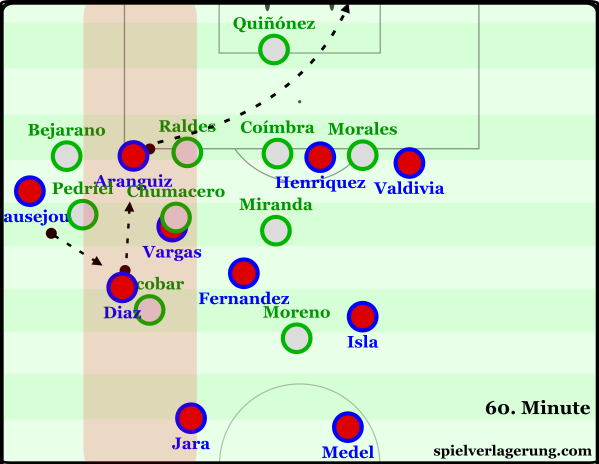
A penetrating one-touch pass from Diaz swaps a vulnerable position by the touchline for a threatening angle for Aranguiz in the half-space.
Another quality of Diaz is that, like many players of this fantastic Chile team, he possesses the ability to withstand and counter opposition pressure. He not only achieves this through his dribbling which creates time and space for himself to move away from the pressed area, but perhaps even more so is successful with his short passing in tight areas.
This latter aspect not only makes himself pressing resistant but reduces the opposition’s ability to enforce a press on the team as a whole as Diaz is often in support close to the ball should a teammate be pressed.
He also offers an improved collective pressing resistance through his intelligent positioning. By dropping between the centre-backs (although something he doesn’t do as commonly as some pivots), he can open the half-spaces for the now-wide centre-backs to move into which can offer some resistance against a press with two strikers whilst the extra man offers multiple benefits; this being one of them. On the other hand, when he stays slightly higher than the first line, Diaz can work to create triangles around the opposition press whilst work to open the wider spaces in midfield also.
Aside from the attributes he provides during Chile’s possession, Diaz is also a defensively-important player and utilises his footballing intelligence to read the game and support the back line in interceptions just ahead. His positional support is vital for Medel and Jara which showed later on as he intercepted one of Bolivia’s more threatening attacks to then combine with the also-great David Pizarro in what was a beautiful scene.

In a game of 5 goals, the highlight was an interception, followed by a small combination between David Pizarro and Marcelo Diaz to exploit the counterpress attempted by Bolivia.
With a somewhat of a favourable run-in to the final, Chile are in a strong position to reach the final should they maintain the standard of the performances so far. In the tournament there is no team less-deserving of the cup and permitting the absence of injuries to key players they should pose a strong threat to the main challengers Argentina and Brazil.
Felipe Araya (@felipeavr) has created a video of the game for his Vimeo channel ‘Football Hunting’, I recommend you view it below:
https://vimeo.com/131373350
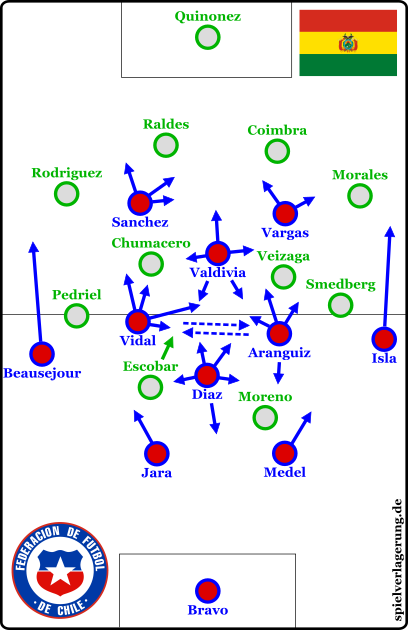
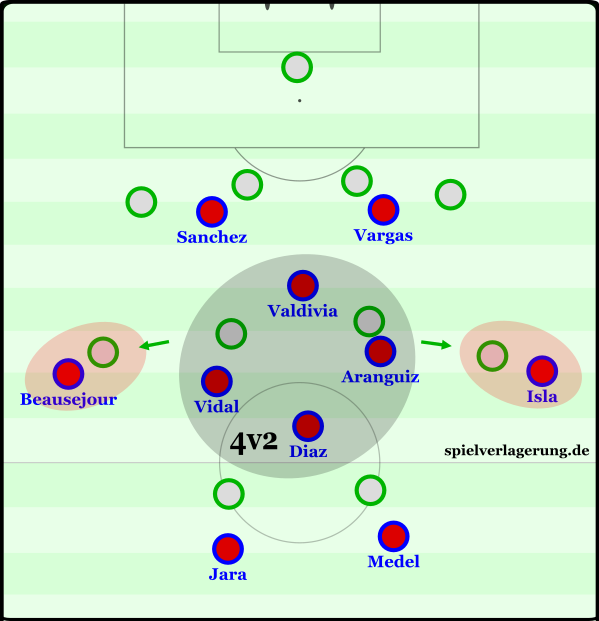

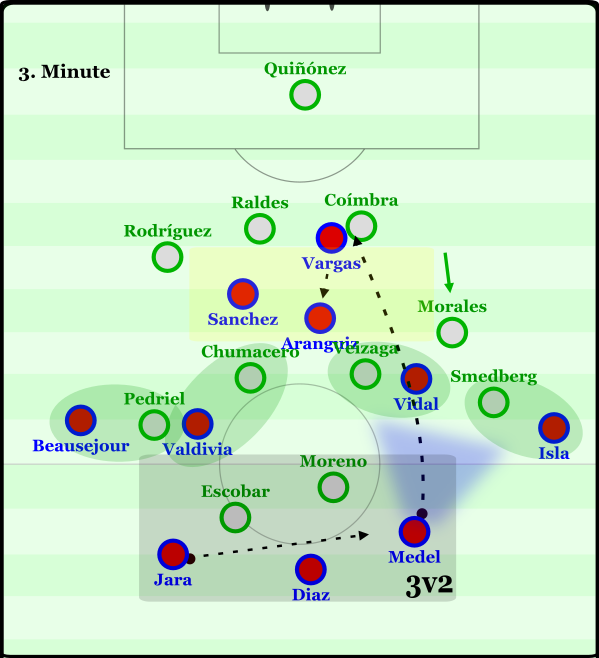

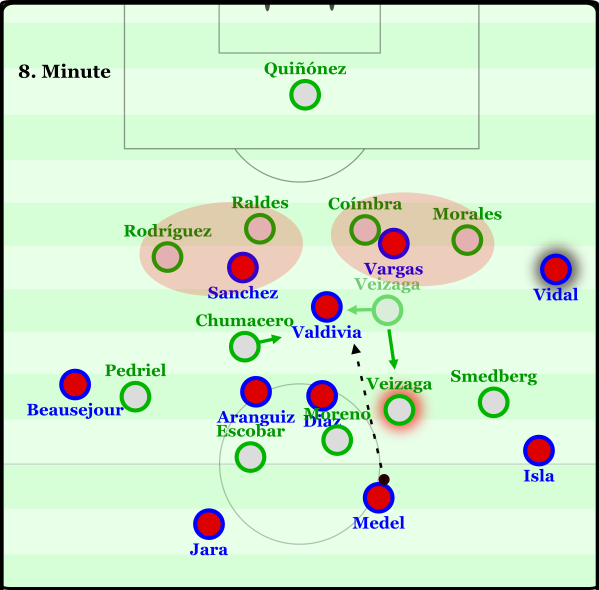
3 Kommentare Alle anzeigen
Valentin June 23, 2015 um 10:31 pm
Chile are so brilliant. The movements, the feeling for spaces, the control of the rhythm and the pressing resistance by Diaz, the sensational through balls and the creativity of Valdivia, the dribblings of Sanchez, the supportive runs of Vidal and Aranguiz, the accurate vertical passes in the first phase of build-up by Jara and Medel, the intense and intelligent pressing, an on and on. I love this team and I desperately hope that they will win their well-deserved title.
Thanks very much for the great article. The matches of Chile deserve an analysis like this and the preview by TT, which was great as well. I hope you will find the time to cover their next matches too.
Gaz A.F June 22, 2015 um 8:13 pm
Could you explain what it means by providing rhythm in possession? What should someone be looking for to spot a particular player or team that can achieve this?
Zach June 22, 2015 um 6:15 pm
Thanks so much or this fantastic article. Chile are the shit and I can’t wait for the Uruguay game.